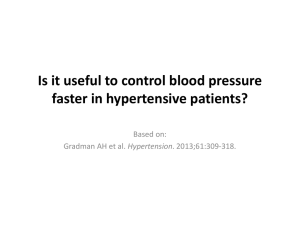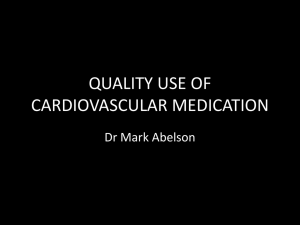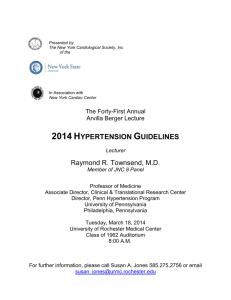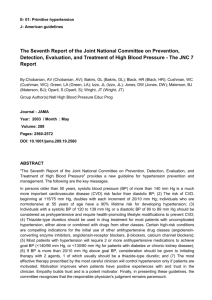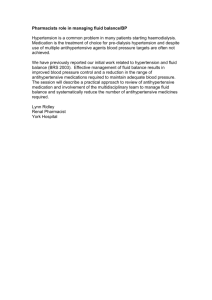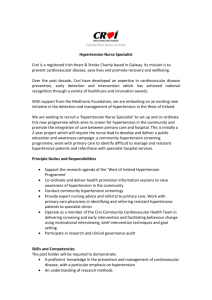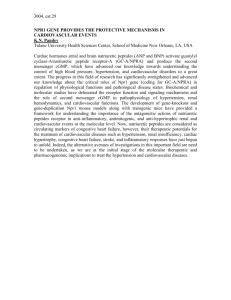New European Guidelines for Management of Arterial Hypertension
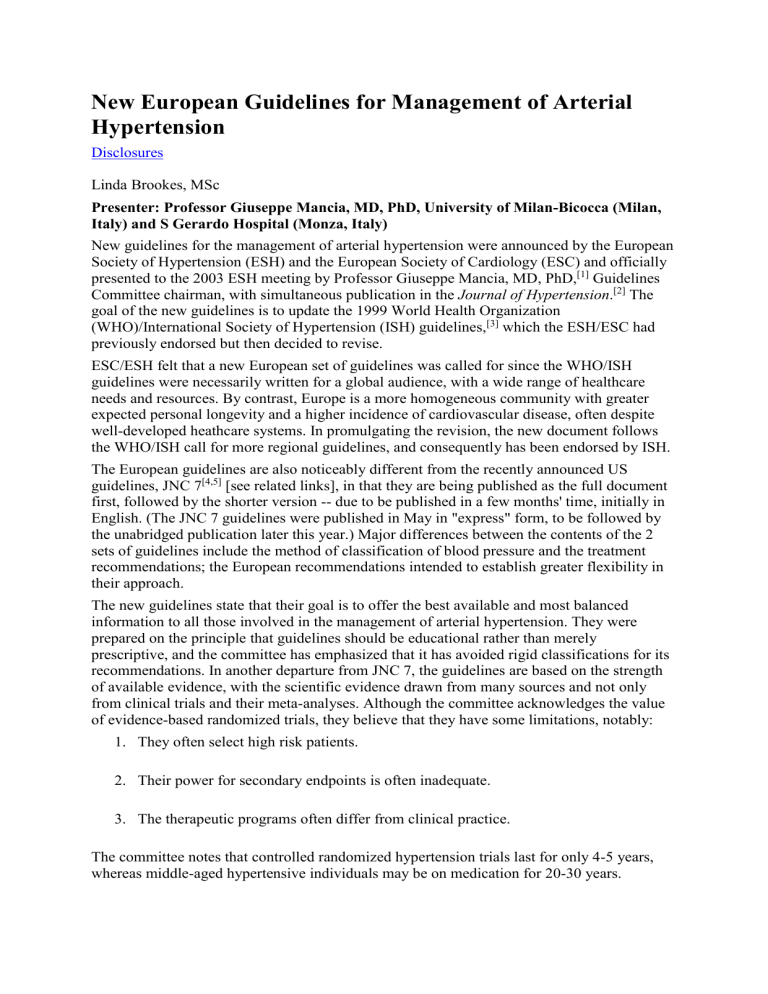
New European Guidelines for Management of Arterial
Hypertension
Disclosures
Linda Brookes, MSc
Presenter: Professor Giuseppe Mancia, MD, PhD, University of Milan-Bicocca (Milan,
Italy) and S Gerardo Hospital (Monza, Italy)
New guidelines for the management of arterial hypertension were announced by the European
Society of Hypertension (ESH) and the European Society of Cardiology (ESC) and officially presented to the 2003 ESH meeting by Professor Giuseppe Mancia, MD, PhD,
[1]
Guidelines
Committee chairman, with simultaneous publication in the Journal of Hypertension .
[2]
The goal of the new guidelines is to update the 1999 World Health Organization
(WHO)/International Society of Hypertension (ISH) guidelines, [3] which the ESH/ESC had previously endorsed but then decided to revise.
ESC/ESH felt that a new European set of guidelines was called for since the WHO/ISH guidelines were necessarily written for a global audience, with a wide range of healthcare needs and resources. By contrast, Europe is a more homogeneous community with greater expected personal longevity and a higher incidence of cardiovascular disease, often despite well-developed heathcare systems. In promulgating the revision, the new document follows the WHO/ISH call for more regional guidelines, and consequently has been endorsed by ISH.
The European guidelines are also noticeably different from the recently announced US guidelines, JNC 7
[4,5]
[see related links], in that they are being published as the full document first, followed by the shorter version -- due to be published in a few months' time, initially in
English. (The JNC 7 guidelines were published in May in "express" form, to be followed by the unabridged publication later this year.) Major differences between the contents of the 2 sets of guidelines include the method of classification of blood pressure and the treatment recommendations; the European recommendations intended to establish greater flexibility in their approach.
The new guidelines state that their goal is to offer the best available and most balanced information to all those involved in the management of arterial hypertension. They were prepared on the principle that guidelines should be educational rather than merely prescriptive, and the committee has emphasized that it has avoided rigid classifications for its recommendations. In another departure from JNC 7, the guidelines are based on the strength of available evidence, with the scientific evidence drawn from many sources and not only from clinical trials and their meta-analyses. Although the committee acknowledges the value of evidence-based randomized trials, they believe that they have some limitations, notably:
1.
They often select high risk patients.
2.
Their power for secondary endpoints is often inadequate.
3.
The therapeutic programs often differ from clinical practice.
The committee notes that controlled randomized hypertension trials last for only 4-5 years, whereas middle-aged hypertensive individuals may be on medication for 20-30 years.
Therefore, the data available to date do not adequately reflect the long-term implications of patient management.
Most importantly for the new guidelines, the committee says it has tried to avoid handing down rigid rules that would constrain clinical judgment on the management of individual patients, who invariably differ in their personal, medical, and cultural characteristics.
Classification of Hypertension
The relationship between blood pressure levels and cardiovascular risk is continuous and direct, and this makes any numerical definition and classification of hypertension arbitrary, the guidelines committee has stressed. Any numerical definitions must be flexible, resulting from evidence of risk and availability of effective and well-tolerated drugs. Since no new epidemiologic evidence has emerged since 1999, the WHO/ISH classification (also that of
JNC 6,
[6]
but not JNC 7) has been retained (Table 1), with the reservation that the threshold for hypertension must be considered as flexible -- ie, higher or lower based on the total
(global) cardiovascular risk profile of each individual. Accordingly, the definition of highnormal blood pressure includes values that may be considered as high (ie, hypertensive) in high-risk individuals or acceptable in those at lower risk.
Table 1. WHO/ISH Definition and Classification of Blood Pressure Levels
Category
Optimal
Normal
High-normal
Hypertension:
Systolic (mm Hg)
< 120
120-129
130-139
Diastolic (mm Hg)
< 80
80-94
85-89
Grade 1 (mild)
Grade 2 (moderate)
Grade 3 (severe)
Isolated systolic hypertension
140-159
150-179
>/= 180
>/= 140
90-99
100-109
>/= 10
< 90
According to the guidelines, when a patient's SBP and DBP levels fall into different categories, the higher category should apply. Moreover, in older patients with isolated systolic hypertension, the blood pressure can also be assessed as grades 1, 2, and 3, according to SBP values in the ranges indicated, provided diastolic values are < 90 mm Hg.
In another departure, the ESH committee believes that use of the term "hypertension" should be avoided in classifying blood pressure, and instead used only to promote the case for tight blood pressure control. Notably, they avoid and do not support the term "prehypertension," as used in JNC 7, although they point out that they were not aware of the term when the new
European guidelines were prepared.
Total Cardiovascular Risk
Total (global) cardiovascular risk makes up an important part of the new guidelines. The committee points out that hypertension is often accompanied by other risk factors. Total cardiovascular risk quantification allows more accurate prognostic evaluation of the patient.
The timing and type of antihypertensive treatment depend on this profile, and the blood pressure threshold and targets for therapy are modified, and the need for accompanying antihypertensive treatment modulated, by it.
Because of this, the classification using stratification for total cardiovascular risk has been expanded from the scheme in the 1999 WHO/ISH guidelines to indicate the added risk in some groups of individuals with normal or high blood pressure (Table 2).
Table 2 Stratification of Risk to Quantify Prognosis
Other Risk Factors and
Disease History
Blood Pressure
Normal
No other risk factors
Average risk
Highnormal
Grade 1 Grade 2 Grade 3
Average risk
Low added risk
Moderately added risk
High added risk
1-2 risk factors
Low added risk
Low added risk
Moderate added risk
Moderate added risk
Very high added risk
>/= 3 risk factors, TOD, or diabetes
Moderate added risk
High added risk
High added risk
High added risk
Very high added risk
ACC
High added risk
Very high added risk
Very high added risk
Very high added risk
Very high added risk
ACC = associated clinical conditions; TOD = target organ damage
The total level of risk is the main indication for intervention, but lower or higher pressure values are also more or less stringent indicators for blood pressure-lowering intervention. The terms "low added," "moderate added," "high added," and "very high added" risk are calibrated to indicate an approximate absolute 10-year risk of cardiovascular disease of < 15%, 15% to
20%, 20% to 30%, and > 30% added risk, respectively, according to Framingham criteria, [7] or an absolute risk of fatal cardiovascular disease of < 4%, 4% to 5%, 5% to 8%, and > 8%, respectively, according to the SCORE (Systemic Coronary Risk Evaluation) chart.
[8]
The word "added" is used because it accounts for an increase in relative risk and, for example, could negate the misleading impression that patients at "low risk" are below average risk
(they are actually at low added risk).
The most common risk factors for cardiovascular disease used for stratification are:
1.
Levels of SBP/DBP
2.
Men aged > 55 years
3.
Women aged > 65 years
4.
Smoking
5.
Dyslipidemia
Total cholesterol > 6.5 mmol/L (> 250 mg/dL) or
LDL-cholesterol > 4.0 mmol/L (> 155 mg/dL) or
HDL-cholesterol :
Men: < 1.0 mmol/L (< 40 mg/dL);
Women: < 1.2 mmol/L (< 48 mg/dL)
6.
Family history of premature cardiovascular disease (men < 55 years, women < 65 years)
7.
Abdominal obesity (abdominal circumference >/= 102 cm [40 in] in men, 88 cm [35 in] in women)
8.
C-reactive protein >/= 1 mg/dL
Obesity is defined as abdominal obesity to draw attention to an important sign of the metabolic syndrome (carrying extra weight may not be a problem, unless it is all carried around the abdominal girth). C-reactive protein was added after increasing evidence pointed to its value as a predictor of cardiovascular events; it has been shown to be as reliable a predictor as LDL-cholesterol levels, and because of CRP's association with the metabolic syndrome.
The importance of target organ damage (TOD) for determining overall cardiovascular risk is also emphasized. The practicing physician should seek evidence for organ involvement, including electrocardiogram/echocardiogram investigations for left ventricular (LV) hypertrophy, ultrasound evidence of arterial wall thickening or atherosclerotic plaque, slight increase in serum creatinine, and microalbuminuria.
Other factors the guidelines points to as influencing prognosis are the presence/absence of diabetes mellitus and of associated clinical conditions, including cerebrovascular disease, heart disease, renal disease, peripheral vascular disease, and advanced retinopathy.
Goals of Treatment
The primary goal of treatment is to achieve the maximum reduction in the long-term total risk of cardiovascular morbidity and mortality. On the basis of current evidence from trials, blood pressures should be lowered to < 140/90 mm Hg at least, and, if tolerated, to levels < 130/80 mm Hg in diabetic patients.
Therapeutic Approach
The guidelines for initiating antihypertensive treatment are based on 2 criteria:
1.
The total level of cardiovascular risk (Table 2), and
2.
SBP and DBP levels (Table 1).
The total level of cardiovascular risk is the main indication for intervention, but lower or higher blood pressure values are also less or more stringent indicators for blood pressurelowering intervention.
Recommendations for individuals with high normal blood pressure (SBP 130-139 or DBP
85-89 mm Hg on several occasions) include:
1.
Assess other risk factors, TOD (particularly renal), diabetes, associated clinical conditions
2.
Initiate lifestyle measures and correction of other risk factors or disease
3.
Stratify absolute risk:
Very high/high : begin drug treatment
Moderate : monitor blood pressure frequently
Low : no blood pressure intervention
Recommendations for individuals with grades 1 and 2 hypertension (SBP 140-179 mm Hg or DBP 90-109 mm Hg on several occasions) include:
1.
Assess other risk factors (TOD, diabetes, associated clinical conditions)
2.
Initiate lifestyle measures and correction of other risk factors or disease
3.
Stratify absolute risk
Very high/high : begin drug treatment promptly
Moderate : monitor BP and other risk factors for >/=3 months:
-- SBP >/= 140 or DBP >/= 90 mm Hg: begin drug treatment
-- SBP < 140 or DBP < 90 mm Hg: continue to monitor
Low : monitor BP and other risk factors for 3-12 months:
-- SBP >/= 140 or DBP >/= 90 mm Hg: consider drug treatment and elicit patient's preference
-- SBP < 140 or DBP < 90 mm Hg: continue to monitor
Recommendations for individuals with grade 3 hypertension (SBP >/= 180 or DBP >/= 110 mm Hg on repeated measurements within a few days):
1.
Begin drug treatment immediately.
2.
Assess other risk factors, TOD, diabetes, associated clinical conditions.
3.
Add lifestyle measures and correction of other risk factors or diseases.
Lifestyle Changes
Lifestyle measures recommended include smoking cessation, weight reduction, reduction of excessive alcohol intake, physical exercise, reduction of salt intake, and increase in fruit and vegetable intake and decrease in saturated and total fat intake.
Choice of Antihypertensive Agents
The guidelines stress that the main benefits of antihypertensive therapy are due to the lowering of blood pressure per se. They list the standard major classes of antihypertensive agents suitable for the initiation and maintenance of therapy:
1.
Diuretics
2.
Beta-blockers
3.
Calcium channel blockers (CCBs)
4.
ACE inhibitors
5.
Angiotensin-receptor blockers (ARBs).
Regarding a final class, alpha-adrenergic receptor blockers, the arm of the only trial testing an alpha-blocker (the doxazosin arm of ALLHAT) was terminated early, for an excess of cardiovascular events. Although the termination has been criticized,
[9]
evidence favoring alpha-blockers as antihypertensive therapy is more scanty than evidence of the benefits of other antihypertensive agents. Nevertheless, alpha-blockers should be considered as a therapeutic option, particularly for combination therapy.
In direct contrast to JNC 7, the European guidelines refrain from recommending specific classes of drugs as initial treatment; nevertheless, the guidelines recognize that there is evidence to support variable effects of specific drug classes on special subsets of patients.
These include the elderly, pregnant women, diabetic patients; patients with concomitant cerebrovascular disease, coronary heart disease, or congestive heart failure; deranged renal function; or resistant hypertension. Specific indications are given for the major classes of antihypertensive drugs (Table 3).
Table 3. Indications for the Major Classes of Antihypertensive Drugs
Drug Conditions Favoring Use
Diuretics (thiazide) CHF; elderly; ISH; hypertensives of African origin
Diuretics (loop)
Diuretics
(antialdosterone)
Renal insufficiency; CHF
CHF; post MI
Beta-blockers
CCBs
(dihydropyridine)
CCBs (verapamil, diltiazem)
Angina pectoris; post MI; CHF (up-titration); pregnancy; tachyarrhythmias
Elderly; ISH; angina pectoris; peripheral vascular disease; carotid atherosclerosis; pregnancy
Angina pectoris, carotid atherosclerosis; supraventricular tachycardia
ACE inhibitors
ARBs
CHF; LV dysfunction; post MI; nondiabetic nephropathy; type 1 diabetic nephropathy; proteinuria type 2 nephropathy; diabetic microalbuminuria; proteinuria; LV hypertrophy; ACE inhibitor cough
BPH; hyperlipidemia Alpha-blockers
ARBs, angiotensin receptor blockers; BPH, benign prostatic hyperplasia; CCBs, calcium channel blockers; CHF, congestive heart failure; ISH, isolated systolic hypertension; MI, myocardial infarction; LV, left ventricular
Finally, if, in the judgment of the physician, treatment can proceed with a single pharmaceutical agent, it is recommended that monotherapy be started gradually in most patients.
Combination Therapy
In direct contrast to JNC 7, the European guidelines state that emphasis on a preferred class of drugs for "first-line therapy" is probably outdated, given the need to use 2 or more drugs in combination in order to achieve goal blood pressure. Taking into account baseline blood pressure and the presence or absence of complications, the guidelines recommend initiating therapy either with an adequate dose of a single agent or with a low-dose combination of 2 agents.
Drug combinations found to be effective and well tolerated include:
1.
Diuretic and beta-blocker
2.
Diuretic and ACE inhibitor or ARB
3.
CCB (dihydropyridine) and beta-blocker
4.
CCB and ACE inhibitor or ARB
5.
CCB and diuretic
6.
Alpha-blocker and beta-blocker
7.
Other combinations (eg, with centrally acting agents, including alpha
2
-adrenoceptor agonists and imidazoline-I
2
receptor modulators, or ACE inhibitors or ARBs) can be used, if necessary.
8.
In many cases, 3 or 4 drugs may be necessary.
There are advantages and disadvantages associated with both monotherapy and combination therapy, the guidelines state. A disadvantage of combination therapy is the potential exposure of patients to unnecessary drugs, but control of blood pressure and its complications is more likely. Use of low-dose combinations are more likely to be free of side effects, and fixed-dose combinations available in Europe are likely to have the practical advantage of optimizing compliance. The decision as to which approach should be prescribed in which patients will likely depend on the initial blood pressure, risk factors, and the presence or possibility of
TOD.
Other Aspects of the Guidelines
As well as detailed sections on treatment of special populations, other hypertension treatment areas covered in the guidelines include the present status of genetic analysis, relative benefits of ambulatory/home blood pressure, follow-up strategies, the importance of long-acting agents, evaluation of adverse effects, and implementation/compliance/adherence. Treatments for associated risk factors include lipid-lowering agents, antiplatelet therapy, and glycemic control.
Implementation of Guidelines
The importance of closing the gap between experts' recommendations and the poor blood pressure control seen in European medical practice is emphasized in the new guidelines. It is hoped that translations of the guidelines into the many European languages will be sanctioned by the national hypertension societies and leagues, so that the guidelines can be widely disseminated to improve blood pressure control in Europe.
References
1.
Mancia G. Presentation of the ESH-ESC Guidelines for the management of arterial hypertension. Program and abstracts of the 13th European Meeting on Hypertension;
June 13-17, 2003; Milan, Italy.
2.
Guidelines Committee. 2003 European Society of Hypertension -- European Society of Cardiology guidelines for the management of arterial hypertension. J Hypertens.
2003;21;1011-1053. Available online at: http://www.eshonline.org/ documents/2003_guidelines.pdf
3.
Guidelines Sub-Committee. 1999 World Health Organization - International Society of Hypertension guidelines for the management of hypertension. J Hypertens.
1999;17:151-183.
4.
US Department of Health and Human Services. JNC 7 Express. The Seventh Report of the Joint National Committee on Prevention, Detection, Evaluation, and Treatment of
High Blood Pressure. Available on the NHLBI Web site at http://www.nhlbi.nih.gov
or from the NHLBI Health Information Center, PO Box 30105, Bethesda, MD 20824-
0105. Phone 301-592-8573 or 240-629-3255 (TTY); Fax: 301-592-8563.
5.
Chobanian AV, Bakris GL, Black HR, et al, and the National High Blood Pressure
Education Program Coordinating Committee, The Seventh Report of the Joint
National Committee on Prevention, Detection, Evaluation, and Treatment of High
Blood Pressure. The JNC 7 report. JAMA. 2003;289:3560-3572.
6.
Joint National Committee on Prevention, Detection, and Treatment of High Blood
Pressure. The sixth report of the Joint National Committee on Prevention, Detection, and Treatment of High Blood Pressure (JNC VI). Arch Intern Med. 1997;157:2413-
2446.
7.
Anderson KM, Wilson PW, Odell PM, et al. An updated coronary risk profile. A statement for health professionals. Circulation. 1991;83:356-362.
8.
Conroy RM, Pyörälä K, Fitzgerald AP, et al, on behalf of the SCORE project group
Prediction of ten-year risk of fatal cardiovascular disease in Europe: the SCORE project. Eur Heart J. In press.
9.
The ALLHAT Officers and Co-ordinators for the ALLHAT Collaborative Group.
Major cardiovascular events in hypertensive patients randomized to doxazosin vs chlorthalidone. JAMA. 2000;283:1967-1975.
